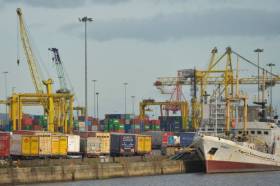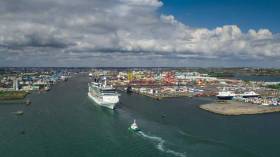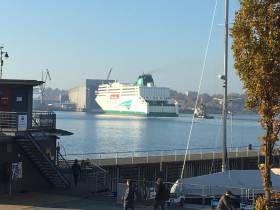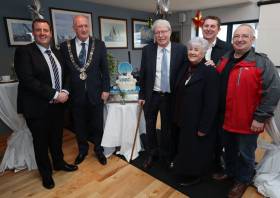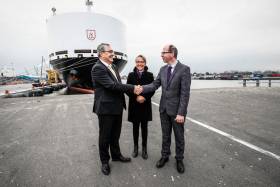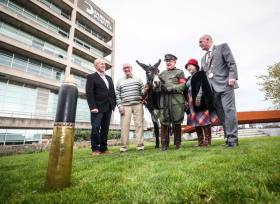Displaying items by tag: Dublin Port
Dublin Port: How Is It Preparing For a Possible No-Deal Brexit?
#ferries - On top of the roof of Dublin Port Company's headquarters, you can see lots of building work amidst all the docked ships at the River Liffey's mouth.
And while that construction is not entirely Brexit-related, management at the port, BBC News reports, says it has to be prepared for the possibility of a no-deal and any potential economic fallout.
The UK is scheduled to leave the EU on 29 March, whether or not there is a negotiated deal. British Prime Minister Theresa May is hoping that her draft Withdrawal Agreement will get through the House of Commons, but preparations are under way in case it does not.
There is agreement across Irish society that Brexit will have an adverse effect on the country, but the worst scenario as far as the Irish government is concerned is that the UK leaves without a negotiated settlement. Politicians here refer to that option as a "hard" Brexit.
The International Monetary Fund forecasts that Ireland's economic growth would take a 4% hit "in the long run" if there is a "cliff-edge" break with the EU, because of the highly integrated nature of the Irish and UK economies.
And the independent Dublin-based think tank The Economic and Social Research Institute estimates that a "hard" Brexit could cost households up to €1,400 (£1,260) a year, because of a potential increase in food prices and possible trade tariffs.
Despite no-one in authority being in a position to predict how Brexit will unfold, the Irish government has already announced plans for an extra 1,000 customs and veterinary staff to work at Dublin and Rosslare ports and at airports, as well as new money to train people in sectors likely to be badly affected.
It has organised a series of very well-attended roadshows around the country with the involvement of state agencies with the theme "Getting Ireland Brexit Ready" for every Brexit scenario.
And there is evidence that more companies - worried about possible delays and resulting costs at Dover - are forsaking the UK land-bridge (incl. Holyhead) and for the new "Brexit-busting" super-ferries (see Afloat's report) that would sail directly between Dublin and Zeebrugge and Rotterdam, bypassing uncertainty in Britain.
It is too early to say what impact they are having, but the development is seen as significant.
There is an Irish political and economic consensus on Brexit.
For political reasons there is widespread agreement that there has to be a so-called "backstop" unless and until there is a wider trade agreement to avoid a hard border on the island of Ireland.
It is feared that such a border could risk a return to violence after a hard-won peace.
For much more click here.
Dublin Port Announces One Million Ro-Ro Freight Units in 2018
For the first time ever, Dublin Port Company has seen one million Ro-Ro freight units passing through the port within the year. The millionth freight trailer in 2018 arrived on board Irish Ferries’ Ulysses when she docked at 6.30am this morning. The truck was one of O’Toole Transport’s vehicles on board the fully booked vessel arriving from Holyhead. Every morning 13 kilometres of trucks roll off the Ro-Ro ferries arriving at Dublin Port, meeting the requirements of the retail sector and industry throughout the country.
This is the first time for Dublin Port to surpass one million Ro-Ro units in a year, and signifies continued growth in Ro-Ro freight moving through the port. Dublin Port now handles nearly 90% of Ireland’s Ro-Ro freight and the addition of the world’s largest short sea Ro-Ro ship, MV Celine, in the past year accounts for an additional 8km of freight lanes / 600 freight units alone. To date, Ro-Ro freight at Dublin Port is ahead by 4.3% compared to this time last year, and up by some 41% on boom time levels last seen in 2007.
The milestone for Dublin Port coincides with a significant week for Irish Ferries, which also sees the arrival of W.B. Yeats scheduled on Thursday, the much-anticipated new luxury ferry that will service the Dublin/Holyhead route during the Winter periods and the Dublin/Cherbourg route from mid-March to September.
Eamonn O’Reilly, Chief Executive, Dublin Port Company, said; “Today marks the one millionth Ro-Ro freight unit arriving at Dublin Port, and the milestone is significant given that Ro-Ro trailers account for more than two-thirds of the port’s overall business. It follows a period of sustained investment by Dublin Port in new infrastructure and better utilisation of lands within the port estate so that customers, such as Irish Ferries, can continue to operate to their full potential as cargo volumes rise. Our investment in port infrastructure is matched by our customers’ investment in new ships and I am delighted to see W.B. Yeats commencing operations from Dublin this week.
Andrew Sheen, Managing Director, Irish Ferries, said; “Irish Ferries has seen strong demand from customers for all our services, especially freight, in the run up to Christmas. Everything from toys and decorations to wrapping paper and wine can be found on board our vessels at this time of year, and with Dublin Port operational 24/7 there is no slowdown as we head into the New Year.”
Plan by Government to Buy Land at Ports in Event of Hard Brexit
#IrishPorts - Plans to acquire port land the Government have said at Dublin Port and Rosslare is in order to prevent congestion caused by any new custom checks, in the event of a no-deal Brexit.
According to RTE News, the Government's contingency plan for a no-deal Brexit was published this evening (Wed, 19 Dec)
The document identifies 19 sectors in which action will be taken should the UK leave the European Union next March without a comprehensive agreement.
Under a chapter entitled 'Next Steps', the Government said it will prioritise "no-deal planning" at its next Cabinet meeting on 3 January.
It will also seek to introduce in the following weeks "necessary legislative measures" which would be required in a no deal scenario.
In a blunt introduction, the paper predicts "a no deal Brexit would potentially involve severe macroeconomic, trade and sectoral impacts [for Ireland]".
It continues: "Grappling with the enormous range of impacts both in the immediate short term and in the longer term will involve difficult and significant choices of a practical, strategic and political nature."
To read more including a comment from Tánaiste Simon Coveney, click here.
Dublin Port - Year in Review 2018
As the main gateway for trade in and out of Ireland, 2018 has been a year of exceptional progress and growth at Dublin Port on several fronts
Trade
In the first nine months of the year, cargo volumes rose by 4.7% to 28.4m gross tonnes, with imports up by 6.0% and exports up by 3.0%. Overall, port volumes grew by 4.7% in the period, and by year-end the port will have seen 36% growth in the past six years alone.
Capital Investment
The extraordinary rate of growth requires Dublin Port to accelerate its capital investment programme to deliver the capacity required for future growth. After decades of under-investment in port infrastructure, Dublin Port plans to invest Ä1 billion over the next ten years. In 2018 alone, investment reached Ä132 million, guided by the Masterplan 2040.
Masterplan Reviewed 2018
With record levels of throughput and growth, managing Dublin Port in accordance with the principles of proper planning and sustainable development is key. This year saw the first review of the Masterplan 2012 – 2040 published.
The review has seen Dublin Port’s underlying long-term growth assumption for throughput rise from 2.5% per annum to 3.3% per annum. On this basis, throughput is expected to increase to 77m gross tonnes by 2040 compared to the 60m gross tonnes anticipated when the Masterplan was published initially.
One of the most important outcomes from the review process is a commitment not to expand by way of infill in Dublin Bay, but rather to continue catering for growth in throughput by utilising the existing footprint of the port, both on the North Quays and within the Poolbeg Peninsula together with the additional 44h of lands acquired for Dublin Inland Port.
Brexit
The past year has also been characterised by preparations for Brexit, and work has commenced on primary border control infrastructure in anticipation of the reintroduction of border controls in Dublin Port should that ultimately prove necessary. Dublin Port continues to work in close co-operation with the various State agencies to facilitate what may be required from March 2019.
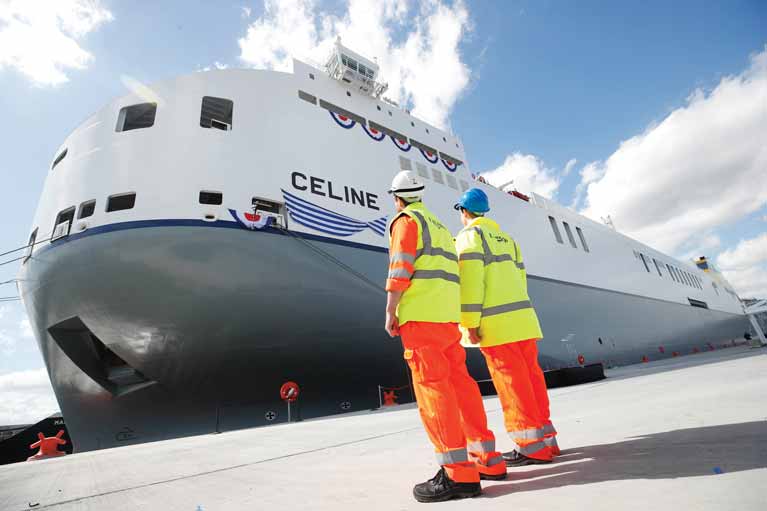 Port workers at the MV Celine, the world’s largest short sea Ro-Ro ship owned by CLdN, christened at Dublin Port
Port workers at the MV Celine, the world’s largest short sea Ro-Ro ship owned by CLdN, christened at Dublin Port
New Ships in Port
There were new “faces” on the River in 2018, with the christening of MV Celine, the world’s largest short sea Ro-Ro ship providing additional capacity for customers trading with Continental Europe via the ports of Zeebrugge and Rotterdam. Representing the next generation of super ferries servicing Dublin Port, her arrival also marked a new milestone in the port’s Alexandra Basin Redevelopment (ABR) Project. With a capacity of 8,000 lane-meters, such is her size, MV Celine would not have been able to call into Dublin Port had development works on three kilometres of berths not already commenced.
 Signing on the dotted line for Dublin Port’s new Pilot Boat were: Michael McKenna, Harbour Master, Dublin Port Company, Eamonn O’Reilly, Chief Executive, Dublin Port Company, Alan Goodchild, MD, Goodchild Marine, Steve Pierce, General Manager, Goodchild Marine
Signing on the dotted line for Dublin Port’s new Pilot Boat were: Michael McKenna, Harbour Master, Dublin Port Company, Eamonn O’Reilly, Chief Executive, Dublin Port Company, Alan Goodchild, MD, Goodchild Marine, Steve Pierce, General Manager, Goodchild Marine
With shipping companies increasingly deploying longer, deeper ships, it was announced that the leading UK boat builder Goodchild Marine Services Limited had secured the contract to construct a new Pilot Boat for Dublin Port. The new 17.1 metre ORC vessel is due for delivery to Dublin Port in July 2019 and will be a welcome addition to the fleet required to service the operational needs of the port.
The boat offers several environmental and design features such as greater fuel efficiency, capacity to cut emissions and an ability to handle high speeds in bad weather owing to its innovative beak bow design which can steady the hull as it pitches into the sea. A separate, flexibly mounted wheelhouse will help to mitigate noise and vibration, making the experience for pilots and crew more comfortable, whilst the hull form significantly reduces fuel consumption due to minimal drag.
 Tall Ship Bellem arrives for The Three Festivals Tall Ships Regatta into Dublin Port in June
Tall Ship Bellem arrives for The Three Festivals Tall Ships Regatta into Dublin Port in June
Life on the River
Celebrating life on the River Liffey has been a focal point for Dublin Port in 2018. The Tall Ships Regatta, Poolbeg Yacht Club Regatta, Clontarf Yacht Club Regatta, East Wall Water Sports Regatta, All in a Row charity event, Dublin Currach Regatta, St. Patrick’s Rowing Club Regatta, Stella Maris Rowing Club Regatta, the Hope Row, the “Three Bridges” Liffey Cruise and the Liffey Swim were among the many highlights that saw the River Liffey and Dublin Bay come to life for the sailing community, bringing together those who enjoy this spectacular amenity for recreation, sporting and spectating purposes.
 Lar Joye, Port Heritage Director
Lar Joye, Port Heritage Director
New Resources
Shining a light on the 300-year-old history of Dublin Port and those who worked there is Lar Joye, who took up the new role of Port Heritage Director during the year. Dublin Port’s archive collection covers the history of the port since 1706, and consists of a priceless collection of maps, museum collections, a vast drawings collection, and the paper archive of the Port. The process of bringing the archives into the public domain has begun, with Lar already working on the photograph collection, preparing 18,000 photographs to be digitised during the year and developing a new online resource here
Looking Back
It was also a year to remember events of the past, including the centenary of the sinking of the mailboat RMS Leinster with support for a new art exhibition at the National Maritime Museum of Ireland, Dun Laoghaire, as well as hosting a lecture series to mark the bicentenary of Bullock Harbour.
 Rinn Voyager launch (from left) Dublin Port Company Harbour Master Michael McKenna and Lord Mayor of Dublin Nial Ring join Poolbeg Training CLG Manager Denis Murphy, Betty Ashe of Pearse Street, Tim Darmody of the Docklands and Jimmy Murray of Ringsend
Rinn Voyager launch (from left) Dublin Port Company Harbour Master Michael McKenna and Lord Mayor of Dublin Nial Ring join Poolbeg Training CLG Manager Denis Murphy, Betty Ashe of Pearse Street, Tim Darmody of the Docklands and Jimmy Murray of Ringsend
Notable milestones during the year also included 25 years of the Rinn Voyager Sailing Project, which Dublin Port helped to establish in response to feedback from the local community for educational training facilities and opportunities. The Rinn Voyager Sailing Project began in 1993 when Dublin Port Company agreed to match EU funding and supply the premises, facilities and engineering expertise to help launch an initiative enabling unskilled school leavers and long-term unemployed people from Regal House, Dublin, to build the vessel.
Launched by the then Irish President, Mary Robinson, the Rinn Voyager has been used to great success by countless local community groups and organisations for outings, rehabilitative programmes and team building exercises through the medium of sail training.
Revenues At Irish Ferries Owner Hit by Disruptions
#Ferry - Irish Continental Group (ICG) revenue fell 1.3 per cent in the first 10 months of the year writes The Irish Times as a result of sailing disruptions and schedule changes, the company said on Thursday.
Group revenue dropped by €3.6 million to €285.3 million reflecting changes in the ferries division, but that was offset by growth in the container and terminal division.
Turnover in the ferries division fell 6.7 per cent to €172.1 million, €4.9 million of which is attributable to lower charter earnings after the sale of the MV Kaitaki in May 2017 and the Jonathan Swift in April 2018.
The volume of cars Irish Ferries carried decreased by 7.2 per cent to 365,400 on the back of a 7.3 per cent loss in sailings. Freight carryings dropped marginally, again linked to a loss in cruise ferry sailings.
ICG’s WB Yeats vessel, which was due earlier in the year, will be ready for delivery in early-December, the company said in a trading update.
For more on the disruption of the €144m newbuild cruiseferry, click here and Afloat's coverage on the first sea trials that took place earlier this month.
Dublin Port Community Gathers to Celebrate Rinn Voyager Vessel
Members of Dublin’s dockland communities gathered at Poolbeg Yacht Club to celebrate more than 25 years of the Rinn Voyager Sailing Project.
Those in attendance included former volunteers, organisers and participants of the project over the years and saw the 42ft Rinn Voyager blessed during a ceremony. Speeches were also given by Dublin Port Harbour Master Michael McKenna, Lord Mayor of Dublin Nial Ring, Poolbeg Training manager Denis Murphy and former first mate of the Rinn Voyager Darren Dent.
The Rinn Voyager Sailing Project began in 1993 in response to feedback from the community for educational training facilities and opportunities for the communities around Dublin Port. Dublin Port Company agreed to match EU funding and supply the premises, facilities and engineering expertise to help launch the initiative. This enabled a group of unskilled school leavers and long-term unemployed people from Regal House, Dublin, build the Rinn Voyager. Upon completion, the sailing vessel was launched in 1994 by the then Irish President, Mary Robinson and for the past 24 years has been used by local community groups and organisations for outings, rehabilitative programmes and team building exercises through the medium of sail training.
The Rinn Voyager has also been used by drug treatment providers to deliver rehabilitation and reintegration programmes. It is estimated more than 7,300 service users of the Drugs & Alcohol Task Force have benefitted from The Rinn Voyager Sailing Project since their partnership began in 2006. Drug addicts in recovery can experience working and living on board the vessel for short periods of time. This sail training offers participants a challenge and another means with which to engage with drugs treatment and therapy.
Michael McKenna, Dublin Port Company Harbour Master said: “The Rinn Voyager Sailing Project has been a vital initiative for thousands of people in our neighbouring communities over the last 25 years. Dublin Port is very proud to have played its part in the programme and it is wonderful to see so many people benefiting from it. The opportunity to learn new skills and grow through personal development is one which can only enhance our city and let’s hope it continues for a further 25 years.”
Denis Murphy, Manager of Poolbeg Training CLG, which runs the project added: "The Drugs and Alcohol Task Force has utilised the service of the Rinn Voyager since 2006 and has acknowledged how important this unique facility is in helping those recovering from addiction to sail to full clean health and we look forward to continuing this partnership for many years to come. We also acknowledge the invaluable support from Dublin Port Company and look forward to their continued contribution."
French Minister for Transport Elisabeth Borne in Dublin Witnesses French & Irish Ports MoU
French Minister for Transport Elisabeth Borne (pictured centre above) witnessed the signature of a Memorandum of Understanding between Mr Mériadec Le Mouillour (left) on behalf of the Union des Ports Français (UPF) and Mr Michael Sheary, on behalf of the Irish Ports Association (IPA).
The new memorandum of understanding was signed at Dublin Port to strengthen maritime links between French and Irish ports as previously reported by Afloat.ie here
French Minister for Transport Elisabeth Borne in Dublin for Irish Ports Association Meeting
French Minister for Transport Elisabeth Borne will be in Dublin Port for a meeting of the Irish Ports Association and the Union des Ports Français on Friday 23rd November.
Following a first workshop gathering Irish and French ports on 26 July 2018 this meeting aims at discussing the future of maritime routes between Ireland and France.
The Irish Ports Association and the Union des Ports Français will sign a Memorandum of Agreement in the presence of Minister Borne.
Dublin Port Unveil Plaque to Remember Dublin Dockyard War Munitions Factory Workers
A plaque has been unveiled to remember 200 local women who manufactured 18 pounder shells in the Dublin Dockyard War Munitions Factory at Dublin Port.
As Afloat.ie reported earlier, a seminar to mark the centenary of the end of WWI was held in the Dublin Port Company's Port Centre building on Alexandra Road today.
The event was held in advance of the 100th anniversary of Armistice Day, and involved talks from distinguished historians who told the story of Dublin Port and City from 1914-18.
Dublin Port Volumes Grow 36% in Six Years
Dublin Port Company today announced growth in cargo volumes of 4.7% to 28.4m gross tonnes for the first nine months of 2018. Within this total, imports grew by 6.0% and exports by 3.0%.
82% of the port’s volumes are in Ro-Ro trailers or Lo-Lo containers. Ro-Ro volumes grew by 4.3% to 768,000 units in the first three quarters while Lo-Lo containers grew by 5.5% to 544,000 TEU.
Imports of new vehicles grew by 6.0% to 78,000.
Dublin Port accounts for the major part of Ireland’s importation of liquid fuels (petrol, diesel and aviation fuel) and volumes in the year to September were ahead by 9.3% to 3.4m tonnes.
82% of the port’s volumes are in Ro-Ro trailers or Lo-Lo containers
Trade in Bulk Solid commodities increased by 15.9% to 1.7m tonnes. The large increase is due, in particular, to increased imports of animal feeds due to the combination of a very dry summer following on from a harsh winter.
On the tourism side, passenger numbers were ahead by 3.3% with the growth coming from cruise passengers.
|
Gross tonnes |
Q3 2018 YTD |
Q3 2017 YTD |
% change |
|
Imports |
16.9m |
16.0m |
6.0% |
|
Exports |
11.5m |
11.2m |
3.0% |
|
Total throughput |
28.4m |
27.2m |
4.7% |
|
Ro-Ro Freight |
768,022 |
736,462 |
4.3% |
|
Lo-Lo TEU |
543,724 |
515,540 |
5.5% |
|
Trade Vehicles |
77,656 |
73,259 |
6.0% |
|
Bulk Liquid |
3.4m |
3.1m |
9.3% |
|
Bulk Solid |
1.7m |
1.5m |
15.9% |
|
Break Bulk |
0.018m |
0.015m |
19.3% |
|
Total bulk products |
5.2m |
4.6m |
11.5% |
|
Ferry passengers |
1,486,463 |
1,496,025 |
-0.6% |
|
Cruise passengers |
212,297 |
148,798 |
42.7% |
|
Total passengers |
1,698,760 |
1,644,823 |
3.3% |
|
Tourist vehicles |
405,907 |
412,082 |
-1.5% |
Commenting on the trade figures, Eamonn O’Reilly, Chief Executive of Dublin Port Company said:
On growth and investment
“Port volumes in Dublin continue to grow at an extraordinary rate and by the end of this year we are looking at 36% growth in just six years. This rate is outstripping our long-term Masterplan growth rate of 3.3% per annum and underpins the need for us to accelerate our capital investment programme to ensure that Dublin Port has sufficient capacity for future growth.
“After decades of underinvestment in port infrastructure, we need to invest €1 billion in the next ten years. This year alone, we are investing €132m, guided by our Masterplan 2040.
“While we continue to work on the Alexandra Basin Redevelopment (ABR) Project, we will shortly bring our second major strategic infrastructure project to An Bord Pleanála to ensure that we have a pipeline of consented projects ready to go.”
On BREXIT
“We have begun construction of primary border control infrastructure to ensure that Dublin Port is prepared for whatever BREXIT might throw at us. Our preparations are closely coordinated with the various State agencies who will have to carry out inspections on UK freight once BREXIT happens. Having come through the worst of recessions from 2008, our volumes are already 23% higher than they were in 2007. In the timescale of port infrastructure projects, we need to press ahead with our infrastructure projects notwithstanding the uncertainties of BREXIT.”


























